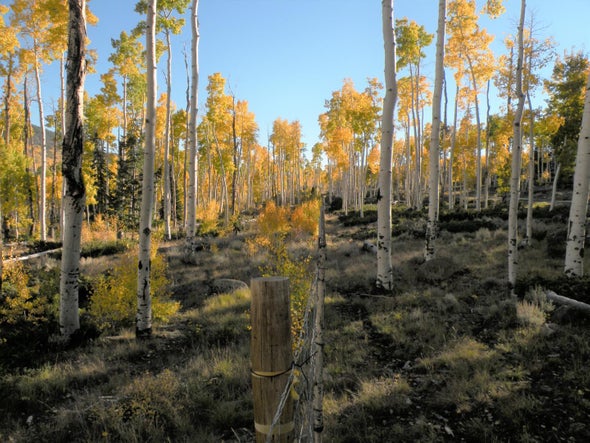(单词翻译:单击)
听力文本
This is Scientific American — 60-Second Science. I'm Annie Sneed.
It lives in south-central Utah. And it's huge. In fact, it is thought to be the largest living thing on the planet. It's a stand of trees, a field of aspens all clones and all connected at the roots. Called Pando, the grove was first characterized by scientists in the 1970s, and it's probably existed for many thousands of years. But now a study finds that this massive, ancient organism is failing.
"More than 80 percent of the entire Pando clone is in a nonsustainable state that has the potential to collapse and significantly reduce the size of this world's largest organism in the next 10 to 20 years." Paul Rogers, director of the Western Aspen Alliance at Utah State University.
The cause of this crisis? Herbivores, mostly deer. Parts of Pando are fenced off, but that section is still under attack. "Young aspen trees are so nutritious that animals really want to get them, particularly late in the year when the rest of the forest plants are senescent and dried up..., I think that there's perhaps some very healthy ones are able to jump over the eight-foot fence."
The deers' aggressive browsing of young aspen poses a huge threat to Pando. "We see a big gap in the demography. And I often use the human analogy that this is a forest that is almost completely composed of senior citizens, and we have no mature, healthy individuals, we have no middle-aged, we have no teenagers, we have no babies. And that's a really dangerous situation for aspen because it really depends on continuous growth of the whole clone. You know? So you should have a really diverse age and height structure."

The problem has largely been created by humans and our game management strategies. Rogers says those strategies need to be reconsidered if we want to protect Pando. And it's not just about saving the world's largest organism for its own sake.
"Aspen here and, in fact, worldwide harbor great amounts of biodiversity..., hundreds of plants and animals that are dependent on aspen ecosystems. In the Western U.S., the lower 48, aspen, second to riparian systems, are the most biodiverse forests that we have. So another term for that is Aspen is a keystone species. So as aspen goes so do all those dependent species. So that's the number one reason."
"Specific to Pando, this closely demarcated 106 acres or 43 hectares is something that's workable that we can see and feel and look at and people know about or are learning more about. And so...as a conservation symbol it's like, if we can't fix this one thing that has this international reputation, what does that say about our greater relationships with the Earth and living compatibly with the planet?"
Thanks for listening for Scientific American — 60-Second Science. I'm Annie Sneed.
参考译文
这里是科学美国人——60秒科学。我是安妮·斯尼德。
它生活在犹他州中南部地区。它体型巨大。事实上,它被认为是地球上最大的生物。它是一片树林,是全部无性繁殖、所有根系连接在一起的一片山杨树林。这片树林被称为“潘多”,在上世纪70年代首次被科学家描述,可能已存在了数千年。但现在一项研究发现,这个体型巨大且古老的生物正在衰退。
“在整个‘潘多'克隆体中,有超过80%的部分处于不可持续状态,未来10到20年,这个全球最大的生物体可能会坍塌,而且面积会大大缩减。”犹他州立大学西部山杨联盟的主任保罗·罗杰斯说到。
这场危机的原因是什么?食草动物,主要是鹿。“潘多”的部分树林被围起来进行保护,但这些受保护区域仍在遭受攻击。“因为小山杨树的养分非常丰富,所以动物们都非常想吃,尤其是在其它森林植物已衰老枯萎的年末。我想可能有一些健壮的动物能跳过8英尺高的围栏。”
鹿对小山杨树的侵略性掠食给“潘多”造成了巨大威胁。“我们看到过人口统计学的巨大鸿沟。我经常用人类来打比方:这片树林几乎全是老年人,没有成年人,没有健康的个体,没有中年人和青少年,也没有婴儿。这对山杨来说是非常危险的情况,因为山杨非常依赖整体无性繁殖的持续增长。因此,山杨树林应该有多样的年龄和高度结构。”
这个问题很大程度上是人类和狩猎管理策略导致的。罗杰斯说,如果我们想保护“潘多”,那就需要重新考虑这些策略。这不仅仅是为了拯救世界上最大的生物体本身。
“事实上,这里以及全球的山杨林都蕴含着大量的生物多样性,有数百种植物和动物依赖山杨生态系统。在位于美国西部的下48州,就生物多样性的丰富程度来说,山杨林仅次于河岸系统。换句话说,山杨是关键物种。因此,随着山杨的衰落,其它所有依赖物种也会随之消失。这是最重要的原因。”
“针对‘潘多'来说,划定这片面积为106英亩或43公顷的区域是可行的,因为我们可以看到、感觉到、观察到,这也是人们了解或正在了解更多的地方。因此,作为保护行动的标志,如果我们不能修复这一具有国际声誉的地点,还何谈我们与地球的更良好关系以及与地球和谐共处呢?”
谢谢大家收听科学美国人——60秒科学。我是安妮·斯尼德。
译文为可可英语翻译,未经授权请勿转载!
重点讲解
重点讲解:
1. fence off (用围栏、篱笆等)将(一块地)围起来;
When she and Luther got their house, they would fence off a lawn and raise roses from cuttings.
等她和卢瑟有了自己的房子,他们就会围起一块草坪扦插玫瑰。
2. dry up (使)枯萎;(使)干透;
As the day goes on, the pollen dries up and becomes hard.
日子一天天过去,花粉干结成了硬块。
3. be composed of 组成;构成;
A methane molecule is composed of one carbon atom attached to four hydrogens.
甲烷分子由1个碳原子与4个氢原子构成。
4. be dependent on 依靠的;依赖的;
You can't be dependent on your parents all your life.
你不可能一辈子靠父母生活。


